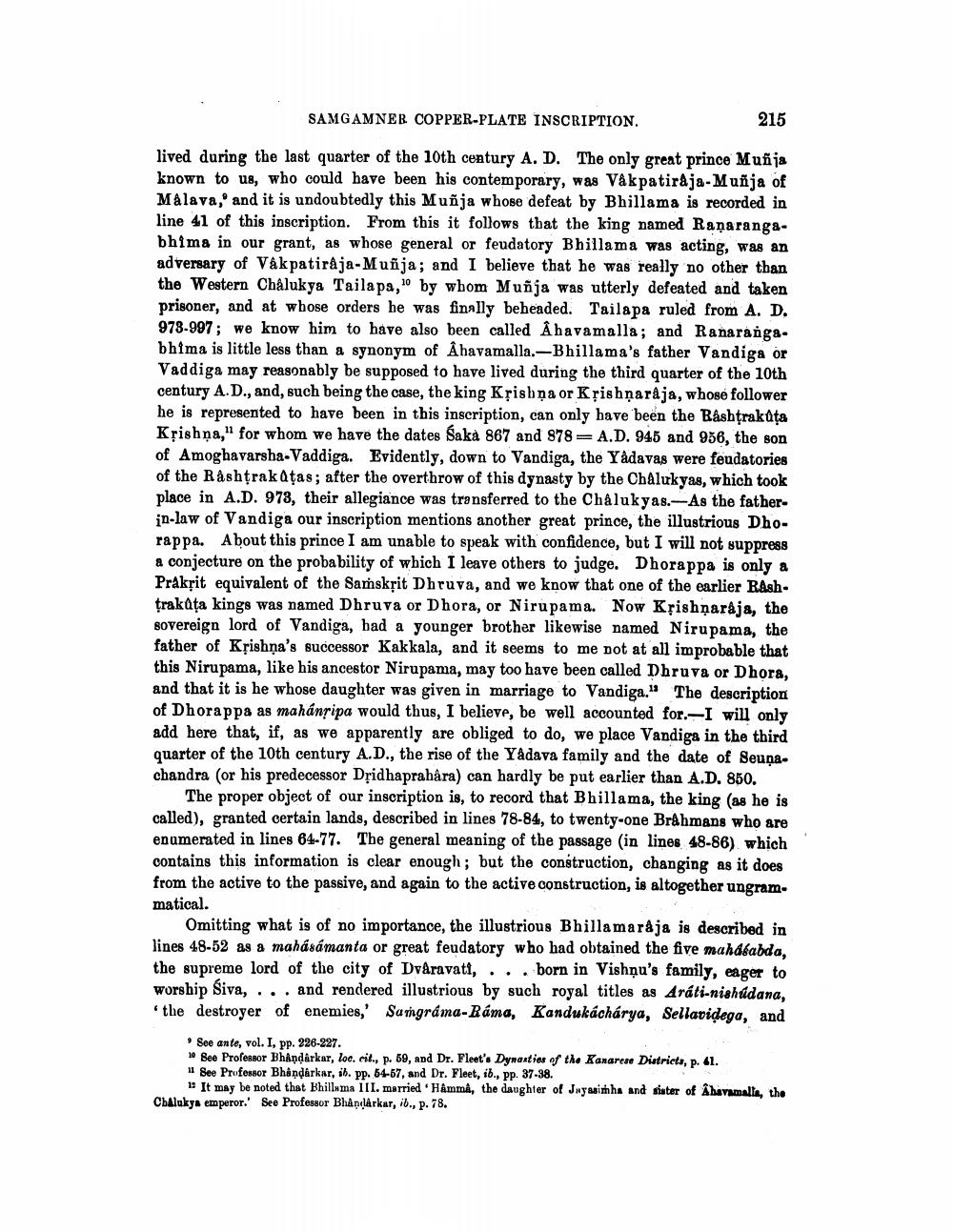________________
SAMGAMNER COPPER-PLATE INSCRIPTION
215
lived during the last quarter of the 10th century A. D. The only great prince Muñja known to us, who could have been his contemporary, was Våkpatiraja Muñja of Málava, and it is undoubtedly this Muñja whose defeat by Bhillama is recorded in line 41 of this inscription. From this it follows that the king named Raņarangabhima in our grant, as whose general or feudatory Bhillama was acting, was an adversary of Vakpatiraja-Muñja; and I believe that he was really no other than the Western Chalukya Tailapa, by whom Muñja was utterly defeated and taken prisoner, and at whose orders he was finally beheaded. Tailapa ruled from A. D. 978-997: we know him to have also been called Åhavamalla; and Ranarangabhima is little less than a synonym of Åhavamalla.-Bhillama's father Vandiga or Vaddiga may reasonably be supposed to have lived during the third quarter of the 10th century A.D., and, such being the case, the king Krisbộa or Kộishnaraja, whose follower he is represented to have been in this inscription, can only have been the Rashtrakata Kțishņa," for whom we have the dates Saka 867 and 878= A.D. 945 and 956, the son of Amoghavarsha-Vaddiga. Evidently, down to Vandiga, the Yadavas were feudatories of the Rashtrakatas; after the overthrow of this dynasty by the Chalukyas, which took place in A.D. 973, their allegiance was transferred to the Chalukyas.--As the fatherin-law of Vandiga our inscription mentions another great prince, the illustrious Dhorappa. About this prince I am unable to speak with confidence, but I will not suppress a conjecture on the probability of which I leave others to judge. Dhorappa is only a Prakpit equivalent of the Samskpit Dhruva, and we know that one of the earlier Rashtrakața kings was named Dhruva or Dhora, or Nirupama. Now Krishnaraja, the sovereign lord of Vandiga, had a younger brother likewise named Nirupama, the father of Krishna's successor Kakkala, and it seems to me not at all improbable that this Nirupama, like his ancestor Nirupama, may too have been called Dhruva or Dhora, and that it is he whose daughter was given in marriage to Vandiga." The description of Dhorappa as mahánripa would thus, I believe, be well accounted for. I will only add here that, if, as we apparently are obliged to do, we place Vandiga in the third quarter of the 10th century A.D., the rise of the Yadava family and the date of Seuņa. chandra (or his predecessor Dridhaprahara) can hardly be put earlier than A.D. 850.
The proper object of our inscription is, to record that Bhillama, the king (as he is called), granted certain lands, described in lines 78-84, to twenty-one Brahmans who are enumerated in lines 64-77. The general meaning of the passage (in lines 48-86) which contains this information is clear enough; but the construction, changing as it does from the active to the passive, and again to the active construction, is altogether ungrammatical.
Omitting what is of no importance, the illustrious Bhillamarája is described in lines 48-52 as a mahásámanta or great feudatory who had obtained the five mahdéabda, the supreme lord of the city of Dvaravati, ... born in Vishņu's family, eager to worship Siva, ... and rendered illustrious by such royal titles as Aráti-nishúdana,
the destroyer of enemies,' Sangrama-Ráma, Kandukáchárya, Sellavidega, and
See ante, vol. I, pp. 226-227.
See Professor Bhandarkar, loc. cit., p. 59, and Dr. Fleet's Dynasties of the Kanarese Districts, p. 41. 1 See Professor Bhandarkar, ib. pp. 54-57, and Dr. Fleet, ib., pp. 37-38.
It may be noted that Bhilluma III. married. Hammâ, the daughter of Jayasinha and sister of Ahavamalla, the Chalukya emperor.' See Professor Bhân lårkar, ib., p. 78.




